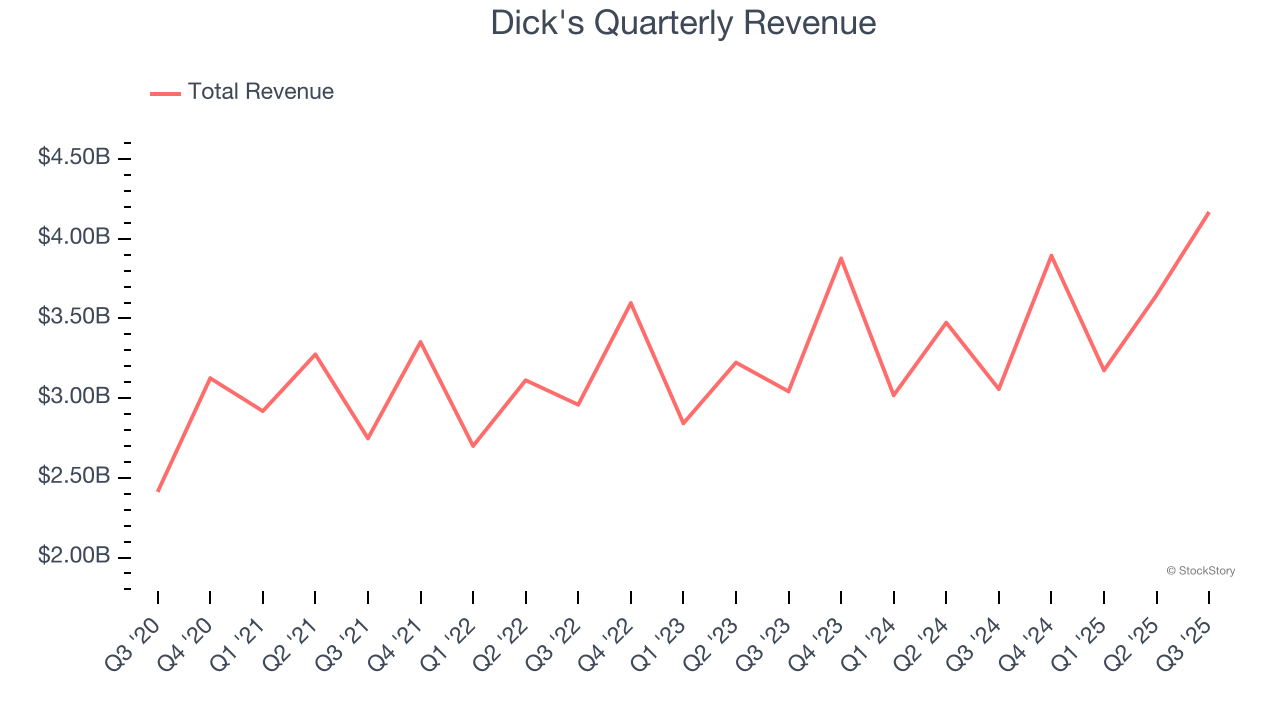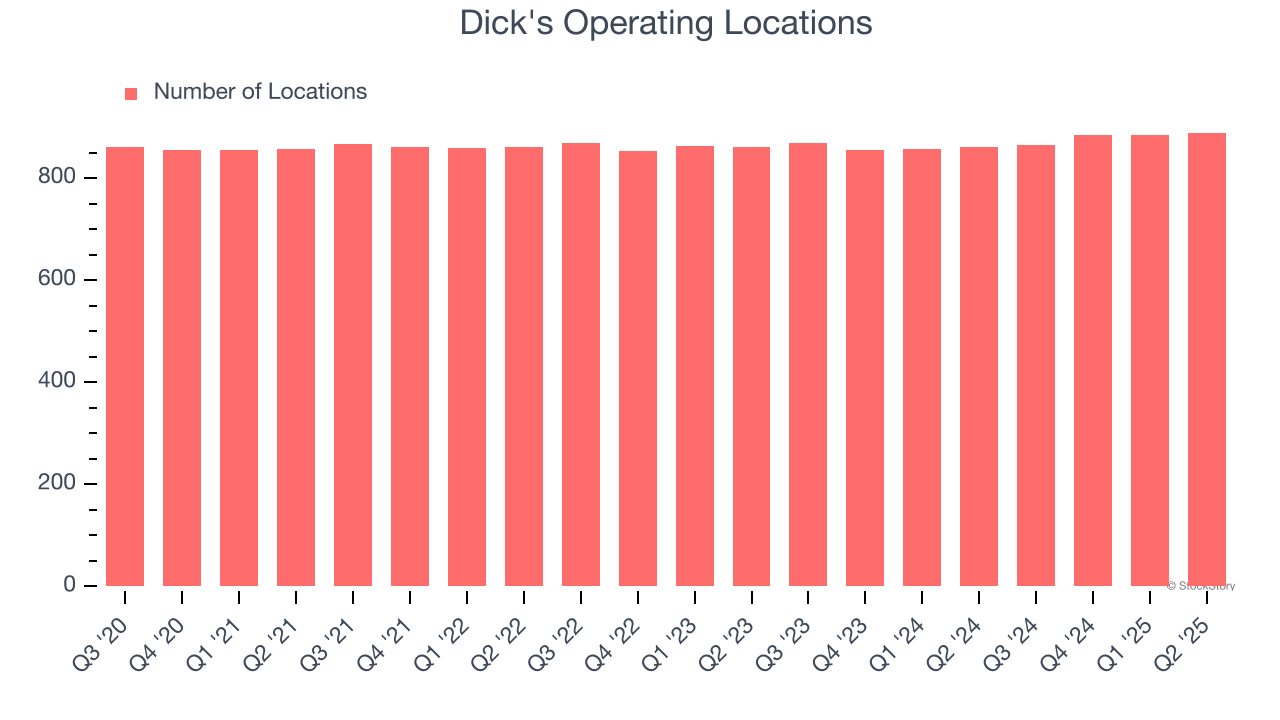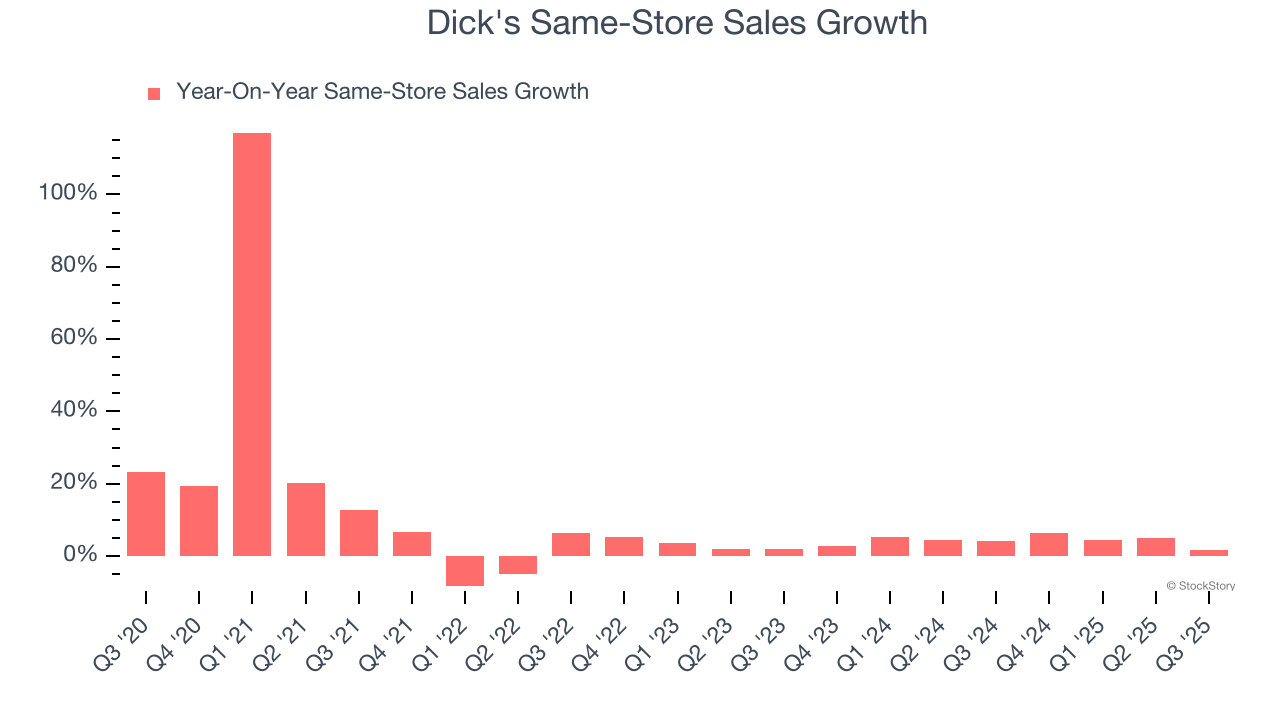
Sporting goods retailer Dick’s Sporting Goods (NYSE:DKS) fell short of the markets revenue expectations in Q3 CY2025, but sales rose 36.3% year on year to $4.17 billion. The company’s full-year revenue guidance of $13.98 billion at the midpoint came in 21.9% below analysts’ estimates. Its GAAP profit of $0.86 per share was 66.8% below analysts’ consensus estimates.
Is now the time to buy Dick's? Find out by accessing our full research report, it’s free for active Edge members.
Dick's (DKS) Q3 CY2025 Highlights:
- On May 15, 2025, the Company announced that it entered into a definitive merger agreement to acquire Foot Locker, Inc., a leading footwear and apparel retailer.
- Revenue: $4.17 billion vs analyst estimates of $4.64 billion (36.3% year-on-year growth, 10.2% miss)
- EPS (GAAP): $0.86 vs analyst expectations of $2.59 (66.8% miss)
- Adjusted EBITDA: -$37.73 billion vs analyst estimates of $459.2 million (-905% margin, significant miss)
- The company slightly lifted its revenue guidance for the full year to $13.98 billion at the midpoint from $13.85 billion
- EPS (GAAP) guidance for the full year is $14.40 at the midpoint, roughly in line with what analysts were expecting
- Operating Margin: 2.2%, down from 9.4% in the same quarter last year
- Free Cash Flow was -$515.6 million compared to -$139.3 million in the same quarter last year
- Same-Store Sales rose 1.7% year on year (4.2% in the same quarter last year)
- Market Capitalization: $16.52 billion
Company Overview
Started as a hunting supply store, Dick’s Sporting Goods (NYSE:DKS) is a retailer that sells merchandise for traditional sports as well as for fitness and outdoor activities.
Revenue Growth
Reviewing a company’s long-term sales performance reveals insights into its quality. Any business can have short-term success, but a top-tier one grows for years.
With $14.88 billion in revenue over the past 12 months, Dick's is one of the larger companies in the consumer retail industry and benefits from a well-known brand that influences purchasing decisions. However, its scale is a double-edged sword because it’s harder to find incremental growth when you’ve penetrated most of the market. For Dick's to boost its sales, it likely needs to adjust its prices or lean into foreign markets.
As you can see below, Dick’s sales grew at a tepid 7.1% compounded annual growth rate over the last three years (we compare to 2019 to normalize for COVID-19 impacts), but to its credit, it opened new stores and increased sales at existing, established locations.

This quarter, Dick's pulled off a wonderful 36.3% year-on-year revenue growth rate, but its $4.17 billion of revenue fell short of Wall Street’s rosy estimates.
Looking ahead, sell-side analysts expect revenue to grow 49.3% over the next 12 months, an acceleration versus the last three years. This projection is eye-popping for a company of its scale and indicates its newer products will catalyze better top-line performance.
Microsoft, Alphabet, Coca-Cola, Monster Beverage—all began as under-the-radar growth stories riding a massive trend. We’ve identified the next one: a profitable AI semiconductor play Wall Street is still overlooking. Go here for access to our full report.
Store Performance
Number of Stores
The number of stores a retailer operates is a critical driver of how quickly company-level sales can grow.
Over the last two years, Dick's has generally opened new stores, averaging 1.3% annual growth. This was faster than the broader consumer retail sector.
When a retailer opens new stores, it usually means it’s investing for growth because demand is greater than supply, especially in areas where consumers may not have a store within reasonable driving distance.
Note that Dick's reports its store count intermittently, so some data points are missing in the chart below.

Same-Store Sales
The change in a company's store base only tells one side of the story. The other is the performance of its existing locations and e-commerce sales, which informs management teams whether they should expand or downsize their physical footprints. Same-store sales provides a deeper understanding of this issue because it measures organic growth at brick-and-mortar shops for at least a year.
Dick’s demand has been spectacular for a retailer over the last two years. On average, the company has increased its same-store sales by an impressive 4.3% per year. This performance suggests its measured rollout of new stores is beneficial for shareholders. We like this backdrop because it gives Dick's multiple ways to win: revenue growth can come from new stores, e-commerce, or increased foot traffic and higher sales per customer at existing locations.

In the latest quarter, Dick’s same-store sales rose 1.7% year on year. This was a meaningful deceleration from its historical levels. We’ll be watching closely to see if Dick's can reaccelerate growth.
Key Takeaways from Dick’s Q3 Results
We struggled to find many positives in these results. Its full-year revenue guidance missed and its revenue fell short of Wall Street’s estimates. Overall, this quarter could have been better. The stock traded down 8.1% to $189.62 immediately after reporting.
Dick's didn’t show it’s best hand this quarter, but does that create an opportunity to buy the stock right now? We think that the latest quarter is only one piece of the longer-term business quality puzzle. Quality, when combined with valuation, can help determine if the stock is a buy. We cover that in our actionable full research report which you can read here, it’s free for active Edge members.
